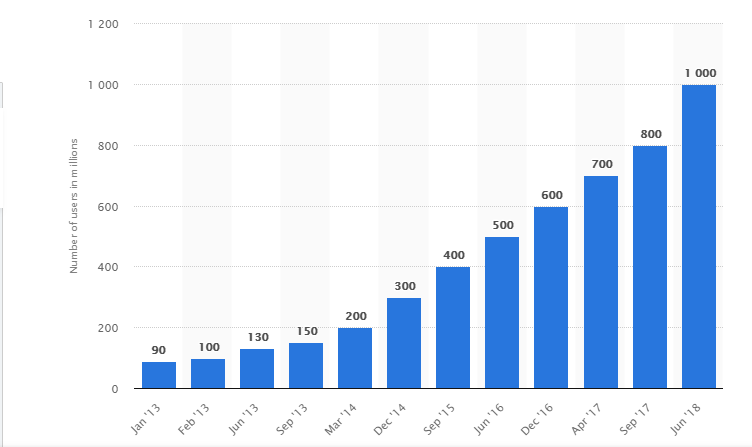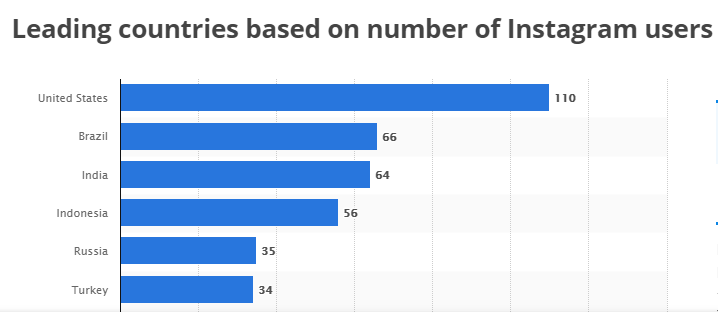Beginning our last post, we start a five-part series on marketing strategies that were specific to the various social media platforms – Facebook, Instagram, Twitter, Snapchat, and LinkedIn. As we told you before, it stems from the evolution of the platforms into their own, out of the shadow of the umbrella term ‘social media’, and so they should be treated so.
In this post, we will take a look at Instagram; the numbers, the demographics, the strategies and more and on Instagram marketing strategies for your online store.
Instagram Reach and Demographic
First, we have to talk about just the kind of reach Instagram enjoys. The photo-sharing platform, which was launched in 2010, bought by Facebook in 2012, has gone from 30 million users then to 1 billion active monthly users! That’s 37% of the internet, just saying. While Facebook and YouTube have plateaued, Instagram usage doubled over the last 3 years.
Moreover, it has 2 million monthly advertisers.
What is really interesting is the demographic Instagram caters to. These are young, 18-24 year-olds, a consumerist group that thrives on instant gratification, purchases and living in the moment. And all these emotions, for better or worse, help businesses looking to sell. And the under-25 makes up 90% of all Insta users!
50% of Instagrammers follow brands, which means that it is as much about friends and socializing as it is about interacting with the outside world.
There are some more statistics, that will specifically interest you from a marketing perspective.
Instagram Marketing
Most brands have an Instagram account. Even companies, groups and more do. It is a sure shot way of being noticed by the 1 billion users, 63% of which log-in to the app daily. 25 million of these accounts are brands, and 80% of users follow at least one such account.
Instagram’s own statistics also tell us that 60% of the users discover new products on the platform, and this engagement on Instagram is several times higher than Facebook, Pinterest, and Twitter.
Instagram is also largely mobile-user drive, and the rise of m-commerce will only help boost its growth. As early as 2015, over a third of Instagram users had purchased something via their mobile and more have been had buying decisions influenced by it. The next time you are browsing through stories, see how often you ‘Swipe Up’ to an ad that comes up in those stories. It’s almost instinctive.
Instagram USP
So what really sets Instagram apart?
It’s its ability to tell a story in the most appealing way there is. Visuals.
Smart phone cameras and Instagram together have given the world more photos than all of human history combined, and these photos tell a story everyone seems to want to hear. Facebook is for talking and reconnecting, Twitter for debating, but Instagram captures the attention of the users in the oldest known form of entertainment – storytelling.
Together with thematic hashtags, influencers and cross-marketing, the young, millennial, hustling crowd, it is the perfect platform for most business owners.
Remember we told you that your marketing/content strategy should send a message, in order to be able to compete with the giants? It’s the easiest to do so via Instagram.
As an online store though, it is the near-universal appeal of the platform (88% of Instagram users are from outside the US), that makes it such a marketing magnet. It literally opens up the globe for you. And with the debut of the in-app checkout for ecommerce stores, all eyes are on whether Instagram will turn into that one-stop strategy for marketers and brands, from discovery to payment.
Read Related Article: How to Use Social Media Channels to Boost Your Hotel Bookings?
Instagram Strategy
What do these numbers mean for your brand? How should you make use of them? What are the strategies you could adopt to use this data to your advantage to market your online store?
Your approach to marketing strategies for Instagram should be five-pronged:
1. Get page and post likes
As you start out, your obvious goal is to make sure that your page and post likes are high, and aim for as much of organic popularity as possible. What’s going to get you there?
A stellar display picture. A compelling bio. A catchy name.
No matter what you do, make sure your display picture will attract people. Have colours, graphics, cartoons. All this while showcasing your product straight up.
The account name, as far as possible, should be as close to the keywords associated with your product. You can go for quirky, but not so complicated that people will not bother decoding it. For brands, your name, as it is, is the best bet. Book your Instagram account as soon as possible, so you have a high chance of securing it.
Netflix, for instance, has a Netflix France as @Netflixfr but for India, its account is @Netflix_in. They can afford to have alterations because of their size, chances are your online store won’t, not at least at the beginning.
Then comes the bio. It has to be quirky, memorable. Start with a straightforward bio, include the most relevant hashtags, maximum one or two, in the bio.
2. Ensure Engagement
Your online store is in the business of selling – either a product or a service or both. But the point of not just Instagram but any social media strategy is to not come across as one. It is to put the human element in your store. How do you do that?
Tag people.
Use relevant, limited and catchy hashtags.
Reply to comments.
Use influencers.
Build a community.
Instagram works on micro-trends. To the outsider, it looks like this is a world of glossy photos. But once you start looking at your industry, you realize that each month, each day, each week, there is something different and unique happening.
If you are a bookseller, for instance, at any given point of time, hashtags like #readdiversebooks, #writersofcolour #feministreadings, will be trending. For June, for instance, #readingqueer is the hot topic because it is Pride Month.
If you sell flowers, there is a different set of micro-trends that are popular on the platform.
The job is to make good all the time you spend browsing on Insta – identify your competitors, the important people in the industry, the influencers who could help promote your product, and even the kind of accounts that would generally need your product/service.
For instance, following and engaging with wedding planning companies as a florist, or with writers as a bookseller, or with glass-makers as a business involved in selling alcohol.
You can also integrate customer service with your Instagram marketing strategy. More and more people reach out for grievance redressal on social media. Make sure to address them, and keep the engagement high.
3. Camera and Content
The right photos (use the rule of the third), the right content (Clear descriptions of product, mixed with dry wit and humour, a support to social causes) and a regular posting strategy help bring in the likes.
Don’t boost your page too soon or for too many followers. Make sure your engaged audience is high. Posting as often as possible is key.
Crowdsourcing content is another way to keep the community engaged. Repost from relevant accounts, offer to feature people on your page.
For pictures, make sure your creatives all present a unified brand image. Using the same filters helps achieve that. Having a design template with your logo and elements from your brand colours also helps bring in a thematic unity in your photos.
Post pictures of products, of services and also of people with your products.
InstaConclusion
Instagram has somehow managed to become the place for both socializing and brand promotions. It’s young demographic, its near-constant use and its visual appeal – all add up to making Instagram a must-have for people and a must-market-on for your online store.
It’s best suited if you are in the handicrafts, apparels, art, photography, shoes, bags, home decor and other such businesses.
For businesses like pharmacy, automobiles, electronics, electricals etc, it may work for your online image to have a semi-active page. Doing that also presents your brand as contemporary and abreast with the times. Often, that’s the kind of image-polishing that brings a customer to your door.




